An Efficient Interface for the Integration of IoT Devices with Smart Grids
Abstract
1. Introduction
2. Background
2.1. Smart Grids
2.2. IoT Communication Protocols
2.3. Open Smart Grid Protocol
3. Related Work
4. Architecture
| Algorithm 1: PUT_to_Partial_Write_request |
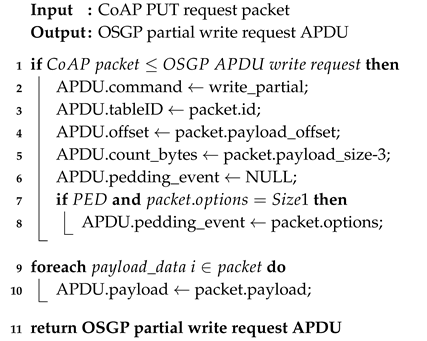 |
| Algorithm 2: POST_to_Full_Write_request |
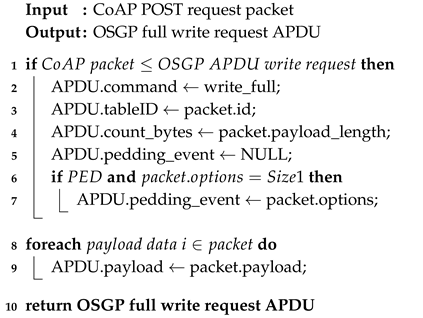 |
| Algorithm 3: GET_to_Partial_Read_request |
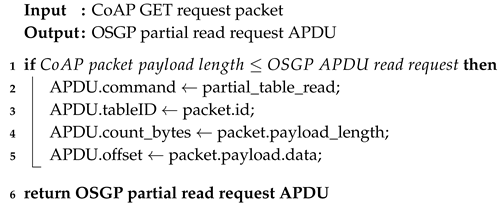 |
| Algorithm 4: GET_to_Full_Read_request |
| Input : CoAP GET request packet Output: OSGP full read request APDU 1 APDU.tableID ← packet.id; 2 APDU.command ← full_table_read; 3 return OSGP full read request APDU |
5. Experimental Results
5.1. Evaluation Platforms
5.2. Results
5.3. Discussion
6. Conclusions
Author Contributions
Funding
Conflicts of Interest
Abbreviations
| 6LoWPAN | IPv6 over Low power Wireless Personal Area Networks |
| ACSI | Abstract Communication Service Interface |
| AMI | Advanced Metering Infrastructure |
| AMR | Automatic Meter Reading |
| AMQP | Advanced Message Queuing Protocol |
| APDU | Application Protocol Data Unit |
| API | Application Interface Programming |
| CBOR | Concise Binary Object Representation |
| CoAP | Constrained Application Protocol |
| COIIoT | CoAP and OSGP Integration for Internet of Things |
| CPS | Cyber-Physical System |
| DDS | Data Distribution Service |
| DNP3.0 | Distributed Network Protocol 3.0 |
| EPC | Electronic Product Code |
| ETSI | European Telecommunications Standards Institute |
| GUI | Graphical User Interface |
| HDLC | High-level Data Link Control |
| HTTP | Hypertext Transfer Protocol |
| IEC | International Electrotechnical Commission |
| IETF | Internet Engineering Task Force |
| IoT | Internet of Things |
| IPv6 | Internet Protocol v6 |
| ITU | International Telecommunication Union |
| JSON | JavaScript Object Notation |
| M2M | Machine-to-Machine |
| MQTT | Message Queue Telemetry Transport |
| MSB | Most Significant Byte |
| OPC | Open Platform Communication |
| OPC UA | OPC Unified Architecture |
| OSGP | Open Smart Grid Protocol |
| OSI | Open System Interconnection |
| PED | Pending Event Descriptor |
| PMU | Phasor Measurement Unit |
| QoS | Quality of Service |
| RFID | Radio-Frequency Identification |
| RPL | Routing Protocol for Low Power and Lossy Networks |
| SG | Smart Grid |
| SOAP | Simple Object Access Protocol |
| TCP | Transmission Control Protocol |
| UDP | User Datagram Protocol |
| URI | Uniform Resource Identifier |
| WSN | Wireless Sensor Networks |
| XaaS | Everything-as-a-Service |
| XMPP | Extensible Messaging and Presence Protocol |
| XML | Extensible Markup Language |
Appendix A
| Algorithm A1: Partial_Write_to_PUT_request |
| Input : OSGP partial write request APDU Output: CoAP PUT request packet 1 packet.version ← CoAP Version; 2 packet.request_type ← PUT; 3 packet.hdr.code ← WRITE; 4 packet.id ← APDU.tableID; 5 packet.command ← APDU.command; 6 packet.options ← 0; 7 packet.payload_length ← APDU.count_bytes; 8 packet.payload.data ← APDU.offset error APDU.payload; 9 return CoAP PUT request packet |
| Algorithm A2: Full_Write_to_POST_request |
| Input : OSGP full write request APDU Output: CoAP POST request packet 1 packet.version ← CoAP Version; 2 packet.request_type ← POST; 3 packet.hdr.code ← WRITE; 4 packet.id ← APDU.tableID; 5 packet.command ← APDU.command; 6 packet.options ← 0; 7 packet.payload_length ← APDU.count_bytes; 8 packet.payload.data ← APDU.payload; 9 return CoAP POST request packet |
| Algorithm A3: Partial_Read_to_GET_request |
| Input : OSGP partial read request APDU Output: CoAP GET request packet 1 packet.version ← CoAP Version; 2 packet.request_type ← GET; 3 packet.hdr.code ← READ; 4 packet.id ← APDU.tableID; 5 packet.command ← APDU.command; 6 packet.options ← 0; 7 packet.payload_length ← offset_size; 8 packet.payload.data ← APDU.offset; 9 return CoAP GET request packet |
| Algorithm A4: Full_Read_to_GET_request |
| Input : OSGP full read request APDU Output: CoAP GET request packet 1 packet.version ← CoAP Version; 2 packet.request_type ← GET; 3 packet.hdr.code ← READ; 4 packet.id ← APDU.tableID; 5 packet.command ← APDU.command; 6 packet.options ← 0; 7 packet.payload.data ← NULL; 8 return CoAP GET request packet |
| Algorithm A5: Write_to_PUT_POST_response |
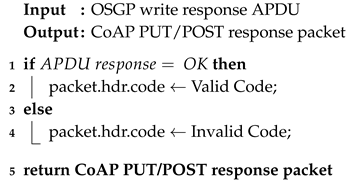 |
| Algorithm A6: Read_to_GET_response |
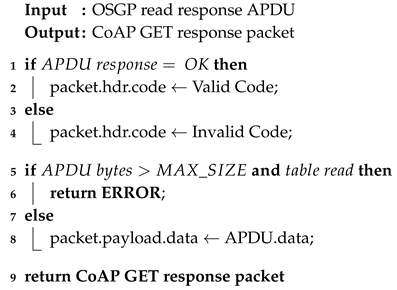 |
| Algorithm A7: PUT_POST_to_Write_response |
 |
| Algorithm A8: GET_to_Read_response |
 |
References
- Razzaque, M.A.; Milojevic-Jevric, M.; Palade, A.; Clarke, S. Middleware for Internet of Things: A Survey. IEEE Internet Things J. 2016, 3, 70–95. [Google Scholar] [CrossRef]
- Marzal, S.; González-Medina, R.; Salas-Puente, R.; Figueres, E.; Garcerá, G. A Novel Locality Algorithm and Peer-to-Peer Communication Infrastructure for Optimizing Network Performance in Smart Microgrids. Energies 2017, 10, 1275. [Google Scholar] [CrossRef]
- Rana, M.M.; Xiang, W.; Wang, E.; Li, X.; Choi, B.J. Internet of Things Infrastructure for Wireless Power Transfer Systems. IEEE Access 2018, 6, 19295–19303. [Google Scholar] [CrossRef]
- Marzal, S.; González-Medina, R.; Salas-Puente, R.; Garcerá, G.; Figueres, E. An Embedded Internet of Energy Communication Platform for the Future Smart Microgrids Management. IEEE Internet Things J. 2019, 6, 7241–7252. [Google Scholar] [CrossRef]
- Kabalci, Y. A Survey on Smart Metering and Smart Grid Communication. Renew. Sustain. Energy Rev. 2016, 57, 302–318. [Google Scholar] [CrossRef]
- Zhang, J.; Hasandka, A.; Wei, J.; Alam, S.; Elgindy, T.; Florita, A.R.; Hodge, B.M. Hybrid Communication Architectures for Distributed Smart Grid Applications. Energies 2018, 11, 871. [Google Scholar] [CrossRef]
- Wang, W.; Xu, Y.; Khanna, M. A Survey on the Communication Architectures in Smart Grid. Comput. Netw. 2011, 55, 3604–3629. [Google Scholar] [CrossRef]
- González, I.; Calderón, A.J.; Figueiredo, J.; Sousa, J. A Literature Survey on Open Platform Communications (OPC) Applied to Advanced Industrial Environments. Electronics 2019, 8, 510. [Google Scholar] [CrossRef]
- Oliveira, L.; Álvares, A. Axiomatic Design Applied to the Development of a System for Monitoring and Teleoperation of a CNC Machine through the Internet. Procedia CIRP 2016, 53, 198–205. [Google Scholar] [CrossRef]
- Cao, Z.; O’Rourke, F.; Lyons, W.; Han, X. Home Energy Management System Incorporating Heat Pump Using Real Measured Data. Sensors 2019, 19, 2937. [Google Scholar] [CrossRef]
- Green, R.C.; Wang, L.; Alam, M. Applications and Trends of High Performance Computing for Electric Power Systems: Focusing on Smart Grid. IEEE Trans Smart Grid 2013, 4, 922–931. [Google Scholar] [CrossRef]
- Dileep, G. A Survey on Smart Grid Technologies and Applications. Renew. Energy 2020, 146, 2589–2625. [Google Scholar] [CrossRef]
- Leite, J.B.; Mantovani, J.R.S. Development of a Self-Healing Strategy With Multiagent Systems for Distribution Networks. IEEE Trans. Smart Grid 2017, 8, 2198–2206. [Google Scholar] [CrossRef]
- Kim, Y.I.; Ko, J.M.; Choi, S.H. Methods for Generating TLPs (Typical Load Profiles) for Smart Grid-based Energy Programs. In Proceedings of the IEEE Symposium on Computational Intelligence Applications in Smart Grid (CIASG), Paris, France, 11–15 April 2011; pp. 1–6. [Google Scholar] [CrossRef]
- Keserica, H.; Sučić, S.; Capuder, T. Standards-Compliant Chat-based Middleware Platform for Smart Grid Management. Energies 2019, 12, 694. [Google Scholar] [CrossRef]
- Silva, R.; Leithardt, V.R.; Silva, J.S.; Geyer, C.; Rodrigues, J.; Boavida, F. A Comparison of Approaches to Node and Service Discovery in 6lowPAN Wireless Sensor Networks. In Proceedings of the ACM Symposium on QoS and Security for Wireless and Mobile Networks (Q2SWinet), Canary Islands, Spain, 28–29 October 2009; pp. 44–49. [Google Scholar] [CrossRef]
- Sheng, Z.; Yang, S.; Yu, Y.; Vasilakos, A.; Mccann, J.; Leung, K. A Survey on the IETF Protocol Suite for the Internet of Things: Standards, Challenges, and Opportunities. IEEE Wirel. Commun. 2013, 20, 91–98. [Google Scholar] [CrossRef]
- Al-Fuqaha, A.; Guizani, M.; Mohammadi, M.; Aledhari, M.; Ayyash, M. Internet of Things: A Survey on Enabling Technologies, Protocols, and Applications. IEEE Commun. Surv. Tutor. 2015, 17, 2347–2376. [Google Scholar] [CrossRef]
- Stanford-Clark, A.; Truong, H.L. MQTT for Sensor Networks (MQTT-SN) Protocol Specification. IBM Corporation. 2013. Available online: http://mqtt.org/new/wp-content/uploads/2009/06/MQTT-SN_spec_v1.2.pdf (accessed on 30 March 2020).
- Jaffey, T. MQTT and CoAP IoT Protocols. Eclipse Newsletter. 2014. Available online: https://www.eclipse.org/community/eclipse_newsletter/2014/february/article2.php (accessed on 30 March 2020).
- Salman, T. Internet of Things Protocols and Standards. 2015. Available online: https://www.cse.wustl.edu/~jain/cse570-15/ftp/iot_prot/ (accessed on 30 March 2020).
- Akasiadis, C.; Pitsilis, V.; Spyropoulos, C.D. A Multi-Protocol IoT Platform based on Open-Source Frameworks. Sensors 2019, 19, 4217. [Google Scholar] [CrossRef]
- Shelby, Z.; Hartke, K.; Bormann, C. The Constrained Application Protocol (CoAP). 2014. Available online: https://tools.ietf.org/pdf/rfc7252.pdf (accessed on 30 March 2020).
- ETSI. GS OSG v1.1.1 (2012-01)—Open Smart Grid Protocol (OSGP). 2012. Available online: https://www.etsi.org/deliver/etsi_gs/OSG/001_099/001/01.01.01_60/gs_osg001v010101p.pdf (accessed on 30 March 2020).
- Albano, M.; Ferreira, L.L.; Pinho, L.M. Convergence of Smart Grid ICT Architectures for the Last Mile. IEEE Trans. Ind. Inform. 2015, 11, 187–197. [Google Scholar] [CrossRef]
- Kursawe, K.; Peters, C. Structural Weaknesses in the Open Smart Grid Protocol. In Proceedings of the International Conference on Availability, Reliability and Security (ARES), Toulouse, France, 24–27 August 2015; pp. 1–10. [Google Scholar] [CrossRef]
- ISO/IEC. ISO/IEC 14908-1: Information Technology—Control Network Protocol—Part 1: Protocol Stack. 2012. Available online: https://www.iso.org/standard/60203.html (accessed on 30 March 2020).
- Lu, G.; Seed, D.; Starsinic, M.; Wang, C.; Russell, P. Enabling Smart Grid With ETSI M2M Standards. In Proceedings of the Wireless Communications and Networking Conference Workshops (WCNCW), Paris, France, 1 April 2012; pp. 148–153. [Google Scholar] [CrossRef]
- Shin, I.J.; Eom, D.S.; Song, B.K. The CoAP-based M2M Gateway for Distribution Automation System using DNP3 in Smart Grid Environment. In Proceedings of the IEEE International Conference on Smart Grid Communications (SmartGridComm), Miami, FL, USA, 2–5 November 2015; pp. 713–718. [Google Scholar] [CrossRef]
- Shin, I.J.; Song, B.K.; Eom, D.S. International Electronical Committee (IEC) 61850 Mapping with Constrained Application Protocol (CoAP) in Smart Grids based European Telecommunications Standard Institute Machine-to-Machine (M2M) Environment. Energies 2017, 10, 393. [Google Scholar] [CrossRef]
- Iglesias-Urkia, M.; Urbieta, A.; Parra, J.; Casado-Mansilla, D. IEC 61850 Meets CoAP: Towards the Integration of Smart Grids and IoT Standards. In Proceedings of the International Conference on the Internet of Things (IoT), Linz, Austria, 22–25 October 2017; pp. 1–9. [Google Scholar] [CrossRef]
- Iglesias-Urkia, M.; Casado-Mansilla, D.; Mayer, S.; Bilbao, J.; Urbieta, A. Integrating Electrical Substations Within the IoT using IEC 61850, CoAP, and CBOR. IEEE Internet Things J. 2019, 6, 7437–7449. [Google Scholar] [CrossRef]
- Nadeem, F.; Aftab, M.A.; Hussain, S.S.; Ali, I.; Tiwari, P.K.; Goswami, A.K.; Ustun, T.S. Virtual Power Plant Management in Smart Grids with XMPP Based IEC 61850 Communication. Energies 2019, 12, 2398. [Google Scholar] [CrossRef]
- Iglesias-Urkia, M.; Orive, A.; Urbieta, A. Analysis of CoAP Implementations for Industrial Internet of Things: A Survey. Procedia Comput. Sci. 2017, 109, 188–195. [Google Scholar] [CrossRef]
- ETSI. Open Smart Grid Protocol (OSGP): Smart Metering/Smart Grid—Standard ETSI TS 104 001 V2.2.1 (2019-01). 2019. Available online: https://www.etsi.org/deliver/etsi_ts/104000_104099/104001/02.02.01_60/ts_104001v020201p.pdf (accessed on 30 March 2020).
- Esspressif Systems. ESP32 Series Datasheet, version 3.4, Expressif Systems, Shanghai; 2020. Available online: https://www.espressif.com/sites/default/files/documentation/esp32_datasheet_en.pdf (accessed on 30 March 2020).
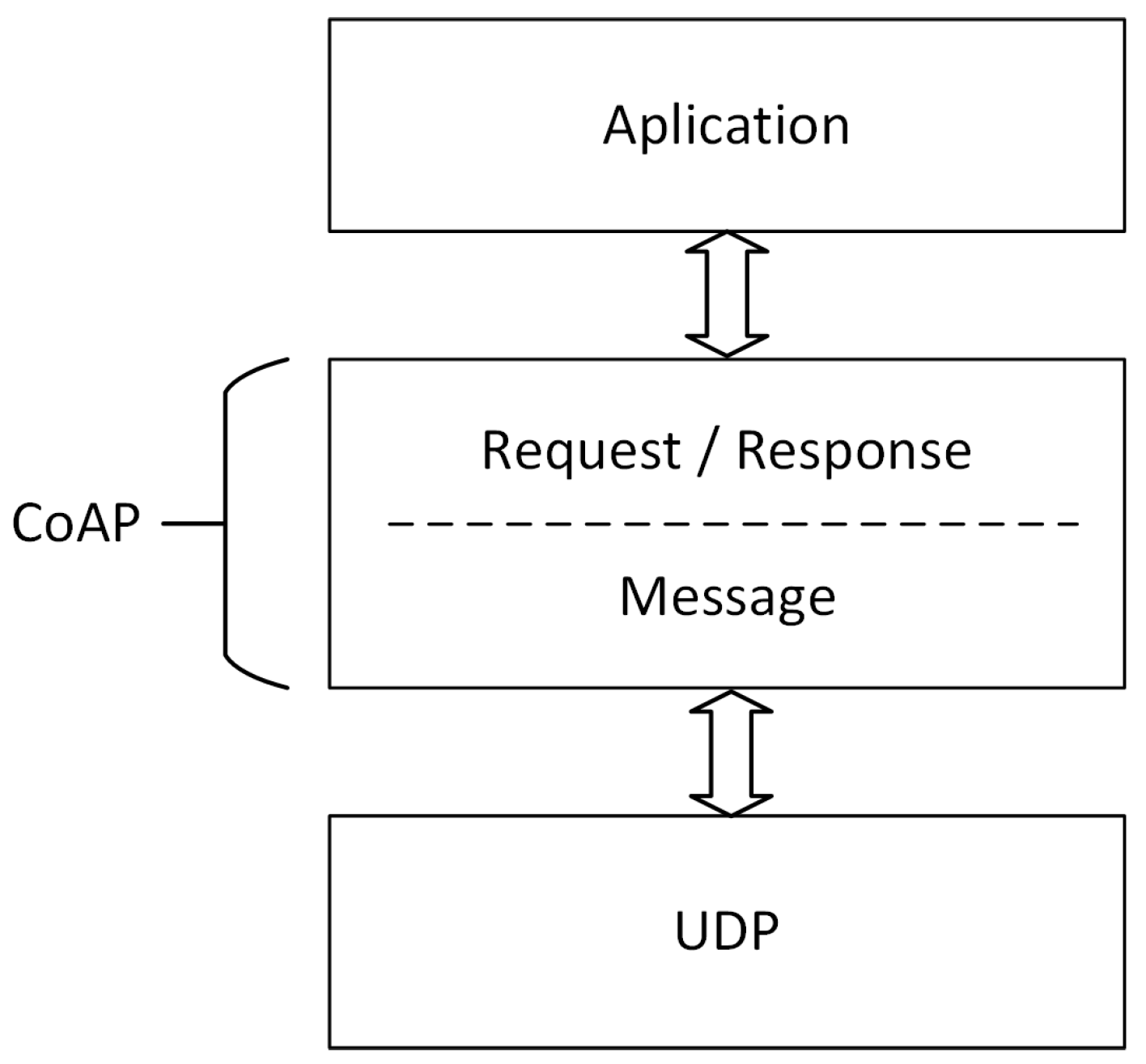
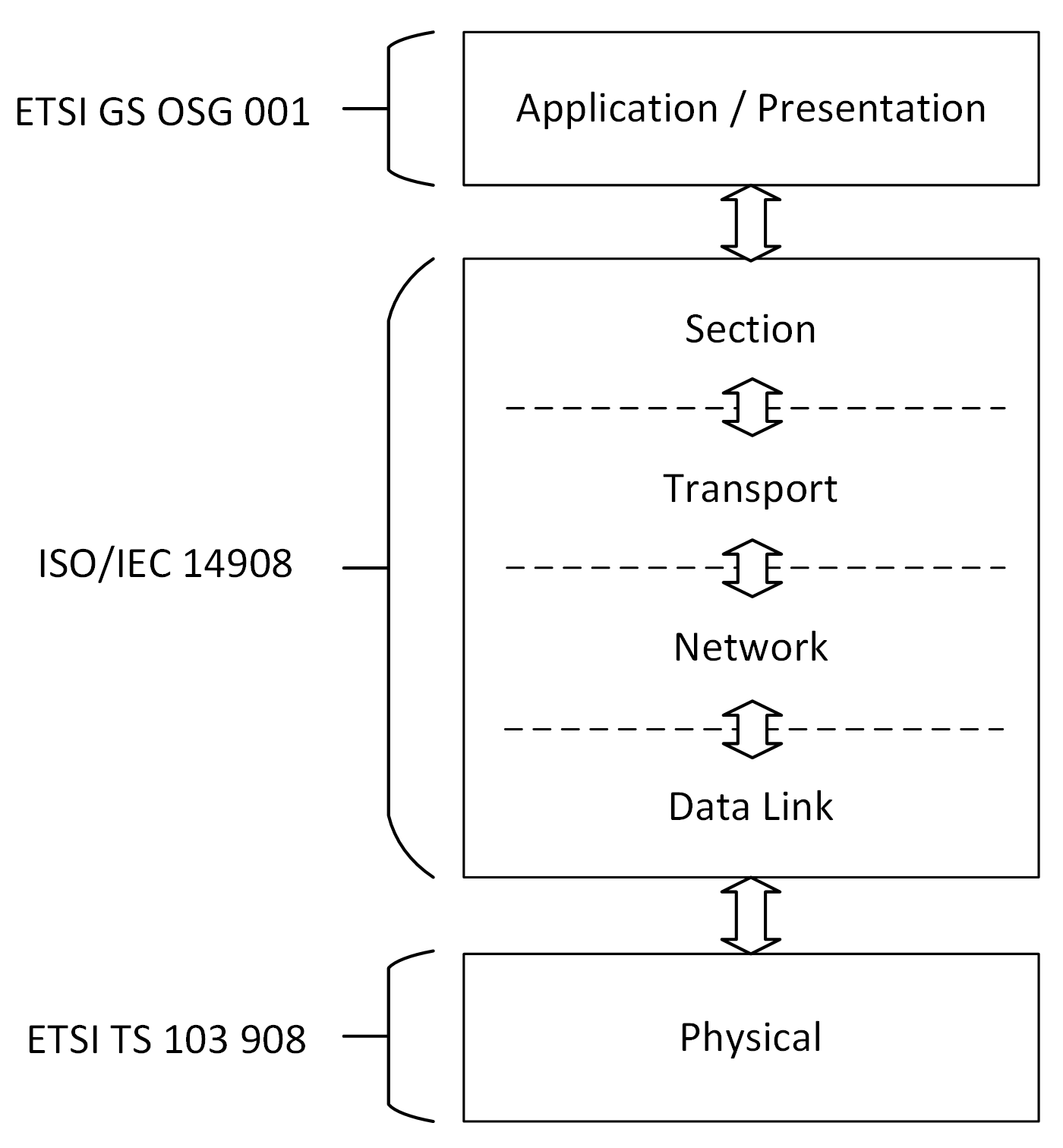
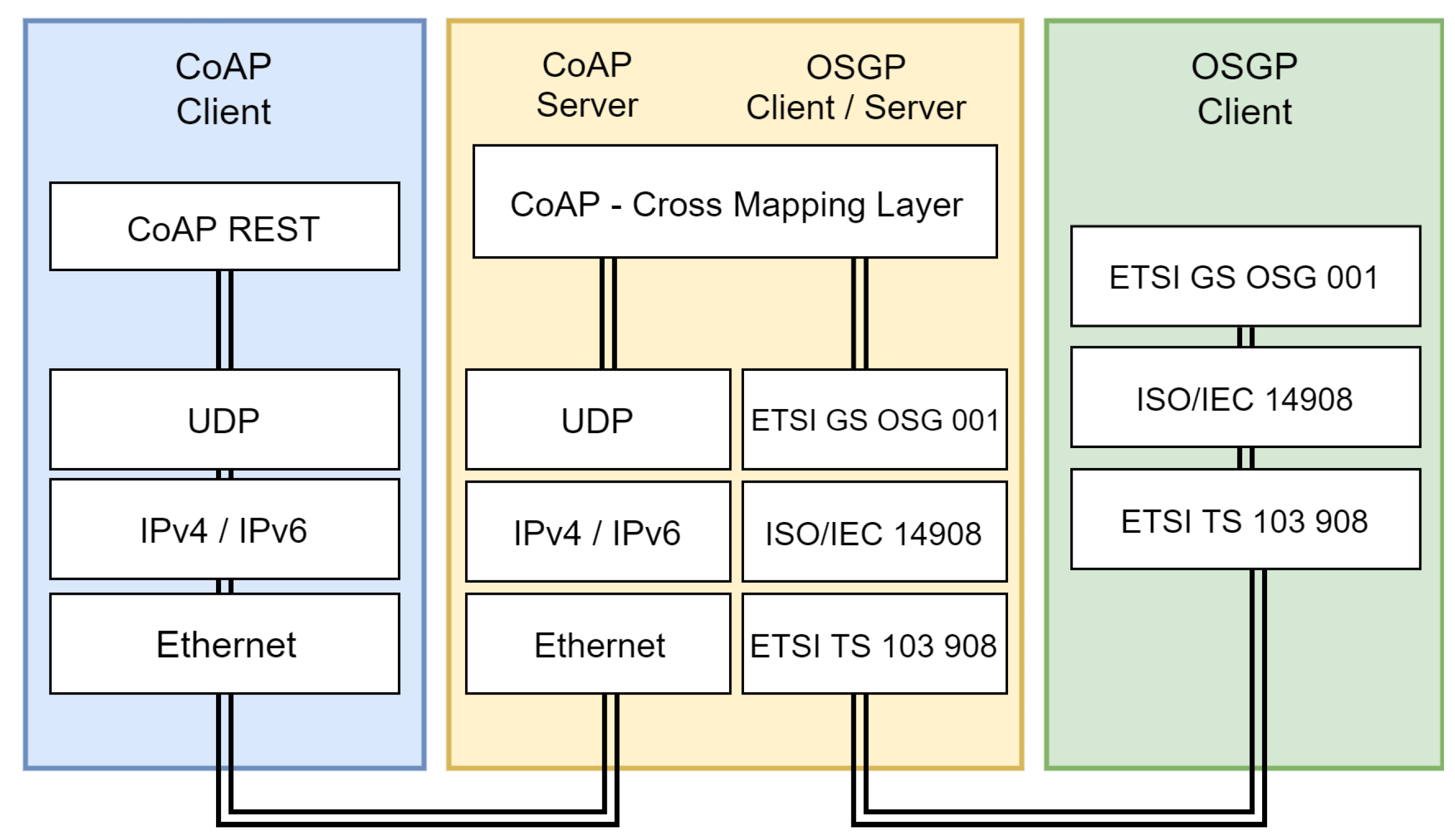
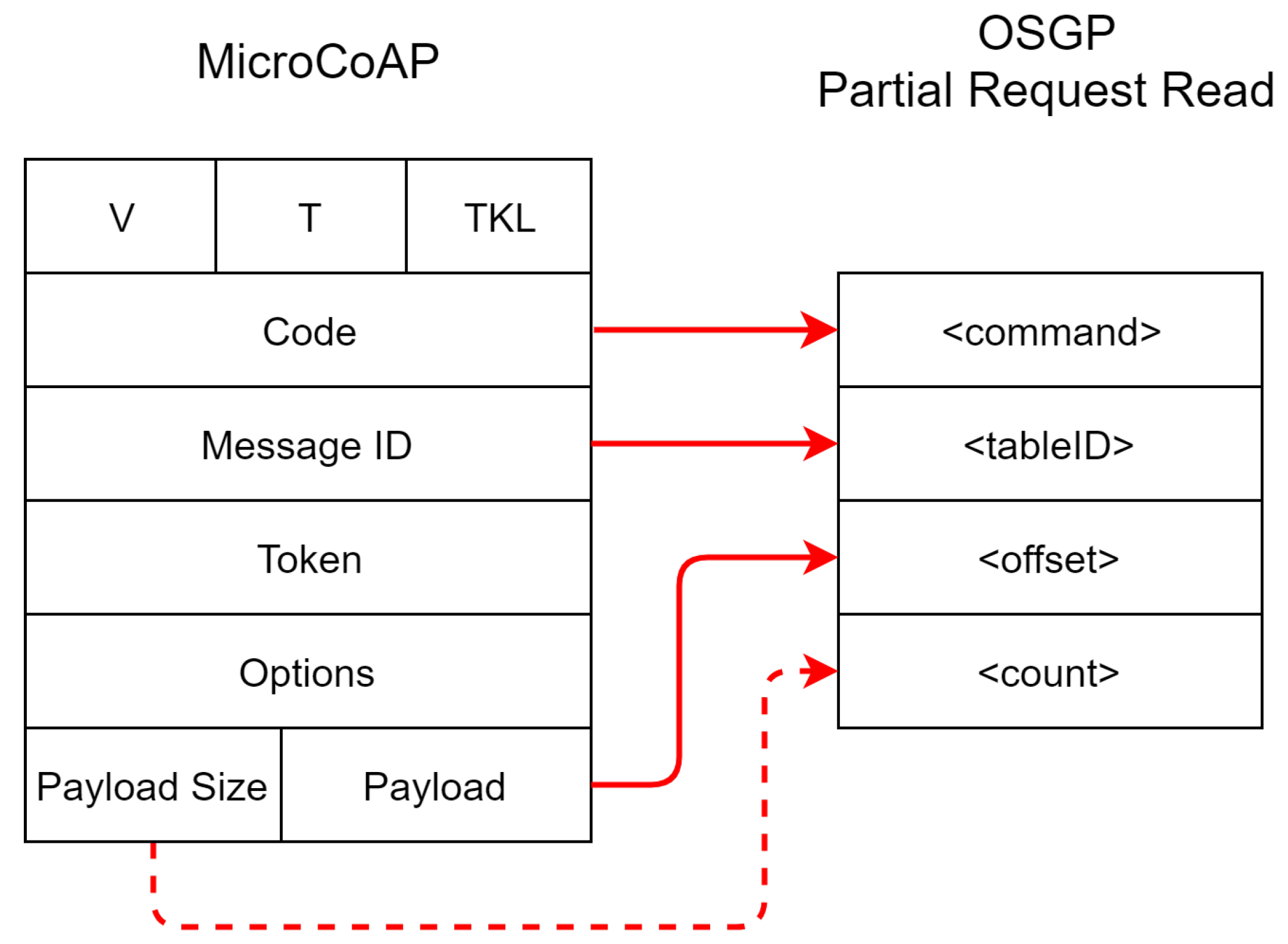
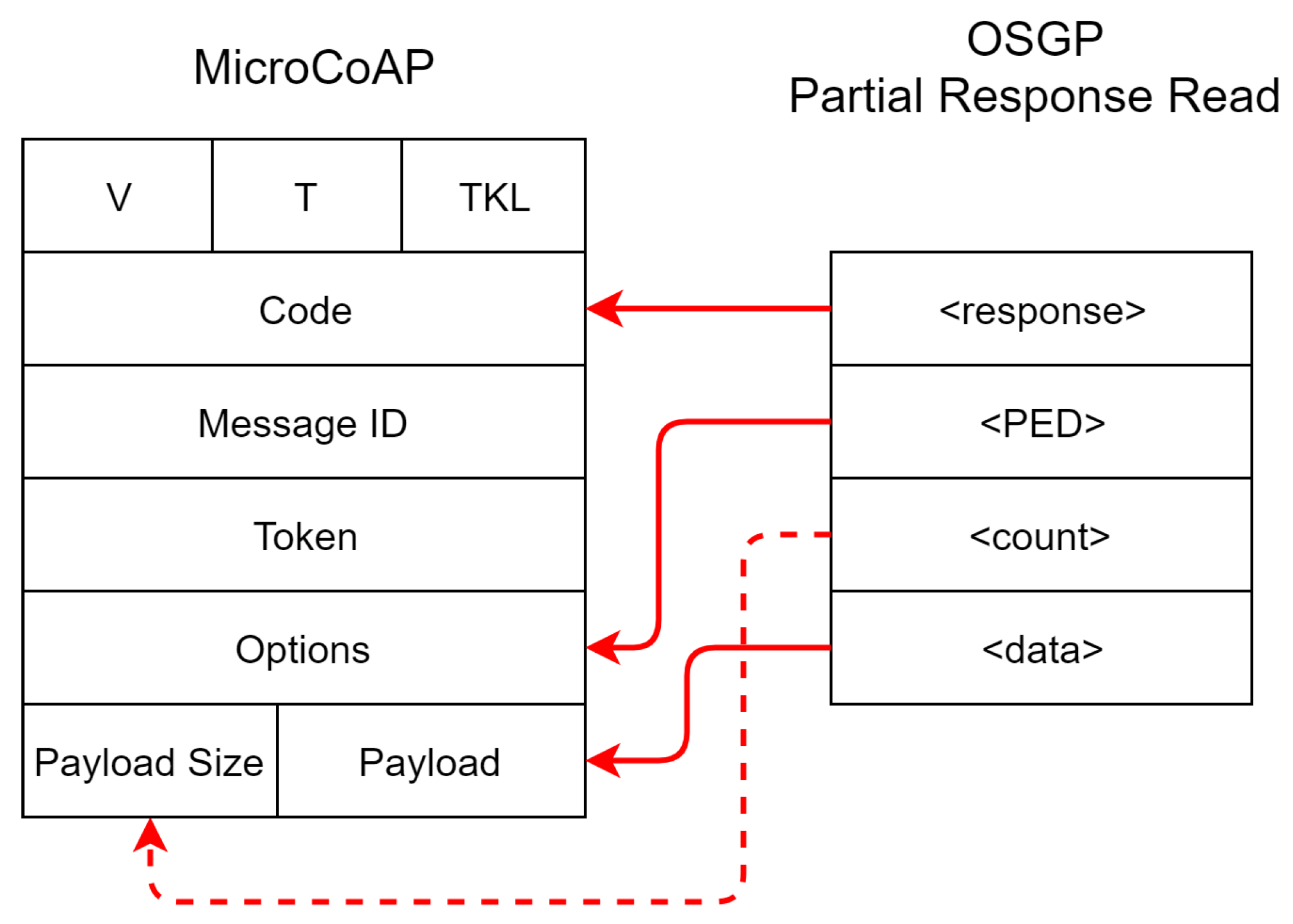
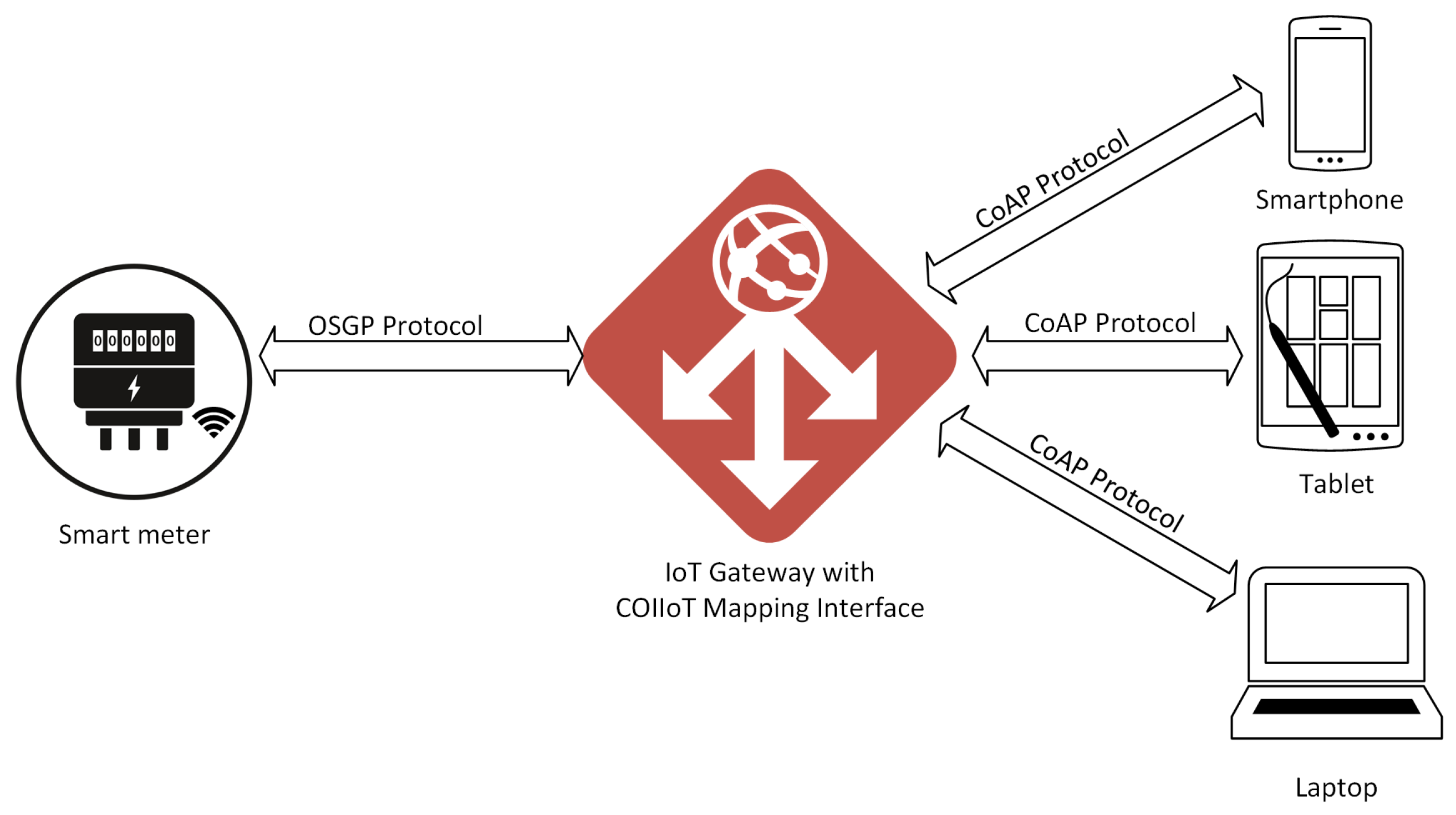
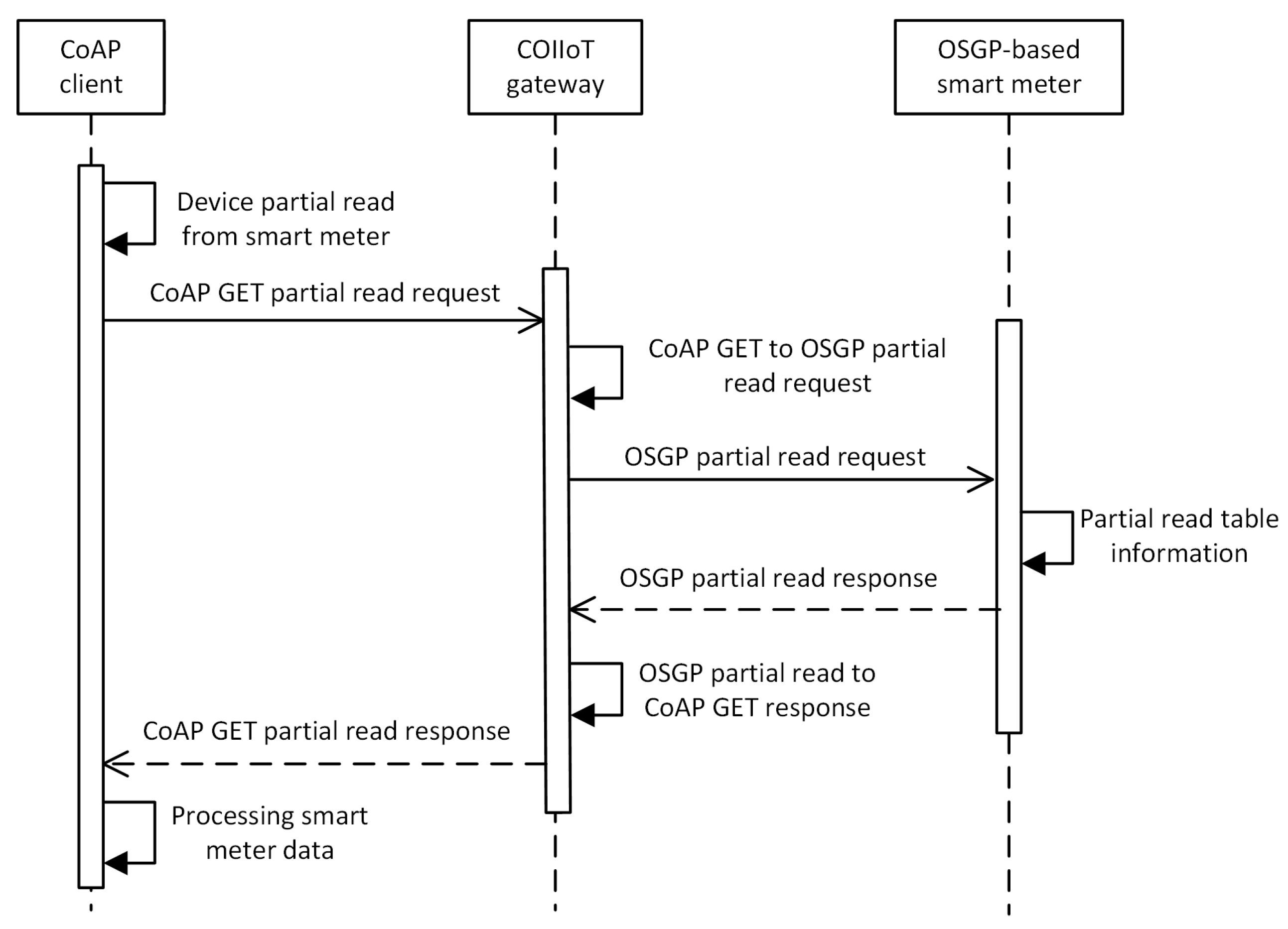
| Work | IoT | SG | Adaptation |
|---|---|---|---|
| [28] | CoAP | ETSI M2M | Native API |
| [29] | CoAP | DNP3.0 | URI mapping |
| [30] | CoAP | IEC 61850 | URI mapping |
| [31] | CoAP | IEC 61850 | URI mapping |
| [32] | CoAP+CBOR | IEC 61850 | URI mapping |
| [33] | XMPP | IEC 61850 | Packet mapping |
| This work | CoAP | OSGP | Packet mapping |
| Type | Method | Algorithm | CoAP (Bytes) | OSGP (Bytes) | Latency (ns) |
|---|---|---|---|---|---|
| Request | PUT→Partial Write | 1 | 512 | 112 | 790 |
| Request | POST→Full Write | 2 | 512 | 88 | 520 |
| Request | GET→Partial Read | 3 | 512 | 64 | 375 |
| Request | GET→Full Read | 4 | 512 | 24 | 275 |
| Request | Partial Write→PUT | 5 | 512 | 112 | 646 |
| Request | Full Write→POST | 6 | 512 | 88 | 390 |
| Request | Partial Read→GET | 7 | 512 | 64 | 196 |
| Request | Full Read→GET | 8 | 512 | 24 | 265 |
| Response | Write→PUT/POST | 9 | 512 | 8 | 470 |
| Response | Read→GET | 10 | 512 | 72 | 440 |
| Response | PUT/POST→Write | 11 | 512 | 8 | 286 |
| Response | GET→Read | 12 | 512 | 72 | 310 |
| Type | Method | Algorithm | Latency (s) |
|---|---|---|---|
| Request | PUT→Partial Write | 1 | 30 |
| Request | POST→Full Write | 2 | 16 |
| Request | GET→Partial Read | 3 | 20 |
| Request | GET→Full Read | 4 | 8 |
| Request | Partial Write→PUT | 5 | 30 |
| Request | Full Write→POST | 6 | 29 |
| Request | Partial Read→GET | 7 | 30 |
| Request | Full Read→GET | 8 | 19 |
| Response | Write→PUT/POST | 9 | 9 |
| Response | Read→GET | 10 | 24 |
| Response | PUT/POST→Write | 11 | 9 |
| Response | GET→Read | 12 | 9 |
© 2020 by the authors. Licensee MDPI, Basel, Switzerland. This article is an open access article distributed under the terms and conditions of the Creative Commons Attribution (CC BY) license (http://creativecommons.org/licenses/by/4.0/).
Share and Cite
Viel, F.; Augusto Silva, L.; Leithardt, V.R.Q.; De Paz Santana, J.F.; Celeste Ghizoni Teive, R.; Albenes Zeferino, C. An Efficient Interface for the Integration of IoT Devices with Smart Grids. Sensors 2020, 20, 2849. https://doi.org/10.3390/s20102849
Viel F, Augusto Silva L, Leithardt VRQ, De Paz Santana JF, Celeste Ghizoni Teive R, Albenes Zeferino C. An Efficient Interface for the Integration of IoT Devices with Smart Grids. Sensors. 2020; 20(10):2849. https://doi.org/10.3390/s20102849
Chicago/Turabian StyleViel, Felipe, Luis Augusto Silva, Valderi Reis Quietinho Leithardt, Juan Francisco De Paz Santana, Raimundo Celeste Ghizoni Teive, and Cesar Albenes Zeferino. 2020. "An Efficient Interface for the Integration of IoT Devices with Smart Grids" Sensors 20, no. 10: 2849. https://doi.org/10.3390/s20102849
APA StyleViel, F., Augusto Silva, L., Leithardt, V. R. Q., De Paz Santana, J. F., Celeste Ghizoni Teive, R., & Albenes Zeferino, C. (2020). An Efficient Interface for the Integration of IoT Devices with Smart Grids. Sensors, 20(10), 2849. https://doi.org/10.3390/s20102849









